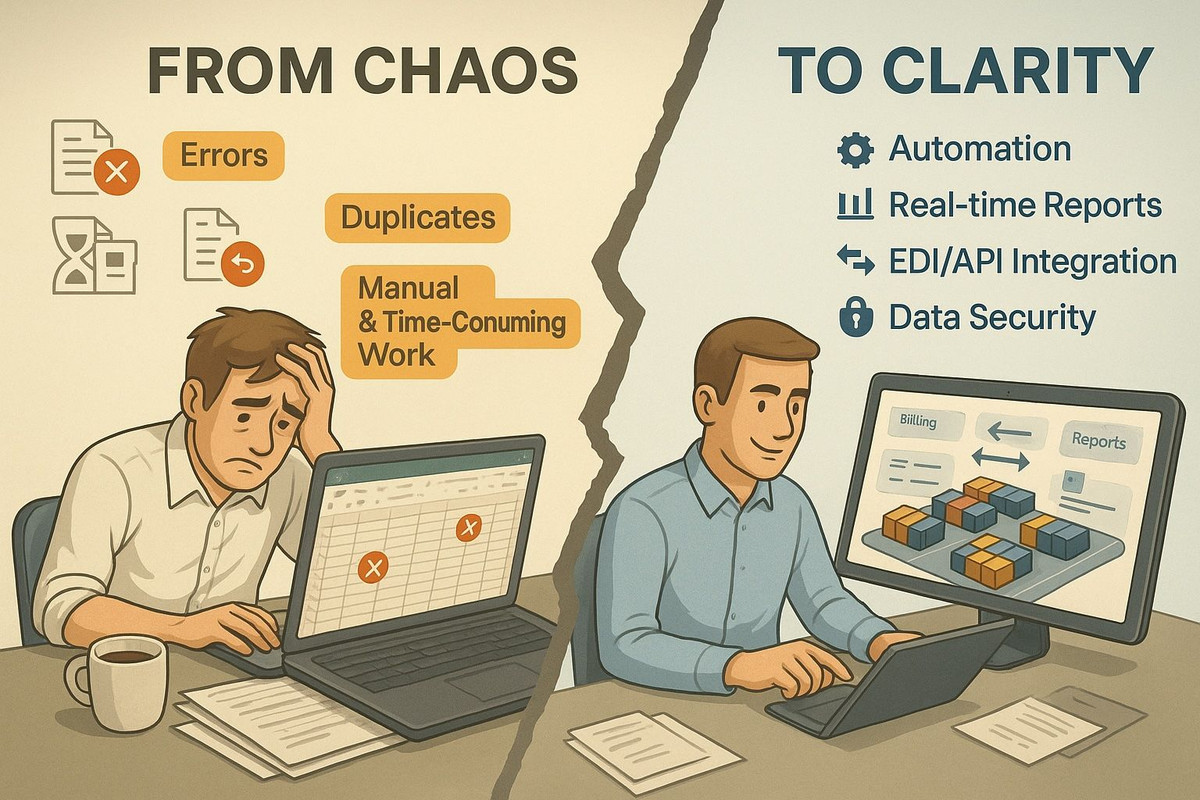Why Manual Spreadsheets Fail in Modern Container Yards
Why Manual Spreadsheets Fail in Modern Container Yards
Meta Description: Learn why spreadsheets are no longer enough for container depots. Discover the risks of manual yard tracking and how digital CYMS tools prevent costly mistakes.

The Hidden Risks of Using Spreadsheets in Container Yard Operations
Intro
For decades, spreadsheets have been the trusted companion of container yard managers. Simple grids, formulas, and endless rows seemed like a cheap and reliable way to track inventory. But the scale of today’s logistics makes this comfort zone a dangerous trap. Terminals that still rely on manual spreadsheets face slow updates, human errors, and poor visibility across operations. In a world where clients demand instant information and carriers expect fast turnaround, paper-like grids are no longer enough to keep control.
The Comfort Zone of Spreadsheets
Spreadsheets earned their place because of accessibility. Any dispatcher could open Excel, design a grid, and start tracking containers by slot and ID. Teams didn’t need expensive IT solutions or training, and managers felt safe with files they could “hold” and share by email. Many small depots still argue: why change something that works? This mindset explains why spreadsheets survived so long. But what feels like control often hides risk. Each file exists in isolation, without real-time updates, without alerts, and with no integration to other systems. When more than one operator edits a file, mistakes multiply, and valuable hours are lost in version control battles.
Where Spreadsheets Break Down
The reality of modern yards shows the limits of manual tracking. When hundreds of containers rotate daily, even one misrecorded slot can cost hours of searching and lead to direct client complaints. Spreadsheet logic collapses once the operation grows:
| Process | Spreadsheet Reality | Digital CYMS Reality |
|---|---|---|
| Slot assignment | Manual typing, prone to errors | Automated, validated in real time |
| Updates | Delayed, sent by email | Instant across all users |
| Transparency | One operator knows, others don’t | Shared live dashboard |
| Error handling | Errors spread unnoticed | Alerts and logs stop issues |
Without a central database, spreadsheets cannot reflect truck turnaround times, container moves, or congestion patterns. And when one file crashes, critical yard knowledge disappears.
The reality of modern yards shows the limits of manual tracking. When hundreds of containers rotate daily, even one misrecorded slot can cost hours of searching and lead to direct client complaints. Spreadsheet logic collapses once the operation grows:
Without a central database, spreadsheets cannot reflect truck turnaround times, container moves, or congestion patterns. And when one file crashes, critical yard knowledge disappears.
The Impact on Yard Operations
Operational pain points become visible fast. Drivers wait longer at gates while staff double-checks Excel rows. Dispatchers spend precious time searching for containers that “exist” in spreadsheets but not in the yard. Mistakes in billing appear because data was not updated in time. Even safety suffers: untracked containers may end up in restricted zones, creating congestion and risk for workers. For customers, these issues translate into frustration and lack of trust. For terminal owners, they become hidden financial losses that grow with each season.
Why Digital CYMS Tools Take Over
Container Yard Management Systems (CYMS) replace scattered spreadsheets with a live, connected platform. Operators see an interactive yard map instead of rows of cells. Every move updates instantly, and slot assignments are validated automatically. Billing modules calculate charges directly from yard events, eliminating disputes. Integration with gate systems, API links, and tracking dashboards ensures no detail is lost. A mid-sized yard of 200–500 TEU can save dozens of staff hours each week by avoiding double entries alone. And when clients ask, “Where is my container?”, staff no longer guess—they show the live screen. With CYMS, information flows in real time across the yard, the office, and the customer.
Voices from the Industry
“Before CYMS, we spent hours checking Excel sheets and still lost track of containers. Now, everything is on screen—slot, status, history. I don’t waste time walking the yard anymore,” shares an operator from a mid-sized depot. Such feedback is not unusual: once teams experience visualization and instant updates, they never want to return to spreadsheets. The change isn’t only about efficiency—it’s about confidence, safety, and credibility in front of clients.
Conclusion
Manual spreadsheets may feel like a safe habit, but they are a costly illusion in modern container yards. They slow down workflows, amplify errors, and limit visibility across operations. Digital CYMS tools transform this reality: instant updates, integrated billing, automated slot assignment, and transparency for all users. For depots and terminals that want to stay competitive, replacing spreadsheets is no longer optional—it’s the first step to smarter operations.
Sources
https://containeryardmsoftware.com/
https://www.porttechnology.org/news/digital-transformation-in-container-terminals/

